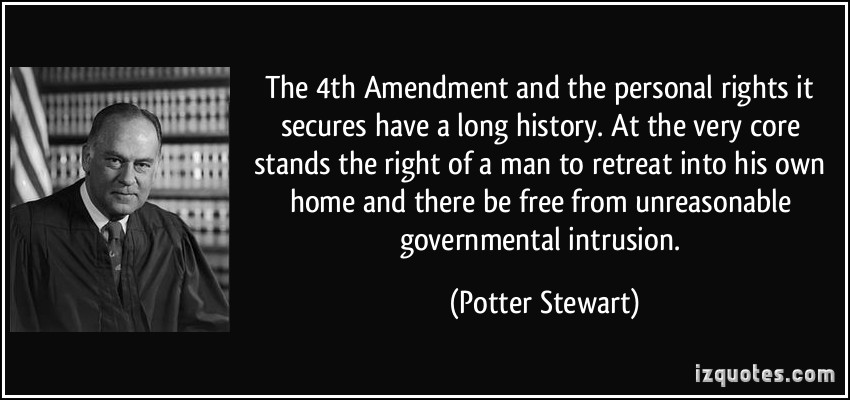The Constitution, through the Fourth Amendment, protects people from unreasonable searches and seizures by the government. [1]
Transcript of The Fourth Amendment:
“The right of the people to be secure in their persons, houses, papers, and effects, against unreasonable searches and seizures, shall not be violated, and no Warrants shall issue, but upon probable cause, supported by Oath or affirmation, and particularly describing the place to be searched, and the persons or things to be seized.“ [2]
Limitations;
Counterbalancing Public Safety and Tyranny:
The Fourth Amendment, however, is not a guarantee against all searches and seizures, but only those that are deemed unreasonable under the law.
Whether a particular type of search is considered reasonable in the eyes of the law, is determined by balancing two important interests:
#1.) the intrusion on an individual’s Fourth Amendment rights.
#2.) legitimate government interests, such as public safety.
Below is a list of Supreme Court Rulings which can be used to determine if an officer violated your Fourth Amendment right. When an officer deprives a civilian of rights, it is known as a Color of Law Crime. A civilian may respond by:
#1.) Filing a Tort Claim with the agency the officer(s) worked for.
#2.) Filing a Criminal Complaint alongside Probable Cause (i.e. “evidence & affidavit“)
#3.) Filing a Civil Action using the Federal Rules of Civil Procedure.
If the below rulings appear unjust or if you have have a unique new circumstance which has never been taken before the Supreme Court, you may challenge the law. You never know— you just may set a precedent.
Supreme Court Rulings to Enforce The Fourth Amendment:
Minnesota v. Carter, 525 U.S. 83 (1998) – “The extent to which an individual is protected by the Fourth Amendment depends, in part, on the location of the search or seizure.” – as follows:
Home:
Payton v. New York, 445 U.S. 573 (1980): “Searches and seizures inside a home without a warrant are presumptively unreasonable.”
However, there are some exceptions. A warrantless search may be lawful:
- “If an officer is given consent to search”;
- Davis v. United States, 328 U.S. 582 (1946)
- “If the search is incident to a lawful arrest”;
- United States v. Robinson, 414 U.S. 218 (1973)
- “If there is probable cause to search and exigent circumstances”;
- Payton v. New York, 445 U.S. 573 (1980)
- “If the items are in plain view”;
- Maryland v. Macon, 472 U.S. 463 (1985).
A Person:
- “When an officer observes unusual conduct which leads him reasonably to conclude that criminal activity may be afoot, the officer may briefly stop the suspicious person and make reasonable inquiries aimed at confirming or dispelling the officer’s suspicions.”
- Terry v. Ohio, 392 U.S. 1 (1968)
- Minnesota v. Dickerson, 508 U.S. 366 (1993)
Schools:
- “School officials need not obtain a warrant before searching a student who is under their authority; rather, a search of a student need only be reasonable under all the circumstances.”
- New Jersey v. TLO, 469 U.S. 325 (1985)
Cars:
- “Where there is probable cause to believe that a vehicle contains evidence of a criminal activity, an officer may lawfully search any area of the vehicle in which the evidence might be found.”
- Arizona v. Gant, 129 S. Ct. 1710 (2009)
- Berekmer v. McCarty, 468 U.S. 420 (1984)
- United States v. Arvizu, 534 U.S. 266 (2002).
- “An officer may conduct a pat-down of the driver and passengers during a lawful traffic stop; the police need not believe that any occupant of the vehicle is involved in a criminal activity.”
- Arizona v. Johnson, 555 U.S. 323 (2009).
- “The use of a narcotics detection dog to walk around the exterior of a car subject to a valid traffic stop does not require reasonable, explainable suspicion.”
- Illinois v. Cabales, 543 U.S. 405 (2005).
- “Special law enforcement concerns will sometimes justify highway stops without any individualized suspicion. “
- Illinois v. Lidster, 540 U.S. 419 (2004).
- “An officer at an international border may conduct routine stops and searches.”
- United States v. Montoya de Hernandez, 473 U.S. 531 (1985).
- “A state may use highway sobriety checkpoints for the purpose of combating drunk driving.”
- Michigan Dept. of State Police v. Sitz, 496 U.S. 444 (1990).
- “A state may set up highway checkpoints where the stops are brief and seek voluntary cooperation in the investigation of a recent crime that has occurred on that highway.”
- Illinois v. Lidster, 540 U.S. 419 (2004).
- “However, a state may not use a highway checkpoint program whose primary purpose is the discovery and interdiction of illegal narcotics.”
- City of Indianapolis v. Edmond, 531 U.S. 32 (2000). [1]
Special thanks to IzQuotes.com for the above graphic we’re utilizing in accordance with Fair Use.
Potter Stewart was nominated by 34th President Dwight Eisenhower as Associate Justice of the United States Supreme Court, serving from 1958 – 1981. He made major contributions to criminal justice reform, civil rights, access to the courts, & Fourth Amendment jurisprudence. [3]
References:
All data used for First Amendment purposes in accordance with the Preamble & Fair Use.
[1]: United States Courts, “What Does the Fourth Amendment Mean?”: www.uscourts.gov/about-federal-courts/educational-resources/about-educational-outreach/activity-resources/what-does-0
[2]: National Archives, “Bill of Rights, A Transcription”: www.archives.gov/founding-docs/bill-of-rights-transcript
Potter Stewart quotes from Iz.Quotes.com: http://izquotes.com/quote/178523
[3]: Friedman, Leon. The Justices of the United States Supreme Court: Their Lives and Major Opinions, Volume V. Chelsea House Publishers. 1978. page 291–292.
**********************************
Other Supreme Court Rulings Organized
All Types of Writs, Orders, & Motions
Other “Civil Rights Self Help” Tools
**********************************
www.ReUniteTheStates.org is brought to you by your friends at Wild Willpower PAC.
Please Support Our Fundraiser on CrowdPAC
